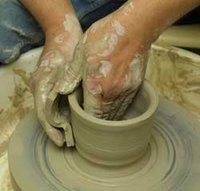 What is the Empty Space?
What is the Empty Space?Take some clay. Feel it in your hands. Now spin it upon a potter’s wheel. What is shaped? A bowl comes out. However, the bowl is defined by an empty space, a space enclosed by the bowl’s very form. The empty space holds the water, fulfilling the purpose of the bowl. The actual physical form of the bowl is reflected by the empty space it projects. The final use and form of the bowl is determined in the moment of artistry used to spin out the shape.
In this example the bowl is made from clay. The clay forms the body, but the actual bowl projects out as more than a clay shell; it must include the “empty space” in its definition. In fact a bowl is more about the “empty space” than the materials comprising the bowl.
In living, we each have a physical form which is mirrored by an empty space. The process of shaping this space is the very definition of a person’s free will.
Free will is the ability to express the very nature of the empty space. Free will is the whim of the moment, the place before the dream, the moment of shaping.
In part, our initial empty space is formed by parents, elders, teachers, culture, our bodies and tendencies of the mind. Yet each person has an incredible degree of freedom to shape their own empty space. At certain times this process is more dramatic than others, such as being a teenager or experiencing a mid-life crisis. These moments stand out as a time to question earlier frameworks that shaped our forms. These times can be difficult due to the twisting around of our core shape and beliefs: a time when our very nature is in flux. Often a person reshapes their empty space without the benefit of outside perspective, adding to the frustration and chances of something “breaking”. A person never truly breaks in this sense, but radically changing one’s own empty space then reflects out to form a vastly different person after the experience.
In this example the bowl is made from clay. The clay forms the body, but the actual bowl projects out as more than a clay shell; it must include the “empty space” in its definition. In fact a bowl is more about the “empty space” than the materials comprising the bowl.
In living, we each have a physical form which is mirrored by an empty space. The process of shaping this space is the very definition of a person’s free will.
Free will is the ability to express the very nature of the empty space. Free will is the whim of the moment, the place before the dream, the moment of shaping.
In part, our initial empty space is formed by parents, elders, teachers, culture, our bodies and tendencies of the mind. Yet each person has an incredible degree of freedom to shape their own empty space. At certain times this process is more dramatic than others, such as being a teenager or experiencing a mid-life crisis. These moments stand out as a time to question earlier frameworks that shaped our forms. These times can be difficult due to the twisting around of our core shape and beliefs: a time when our very nature is in flux. Often a person reshapes their empty space without the benefit of outside perspective, adding to the frustration and chances of something “breaking”. A person never truly breaks in this sense, but radically changing one’s own empty space then reflects out to form a vastly different person after the experience.
We are the light of our own empty space.
Consciousness is the awareness of one’s empty space.
The only limit being the imagination itself.
Be free, be yourself.
- Casey Kochmar
Credit: Article link to Casey's Personal Tao site














COMMENTS